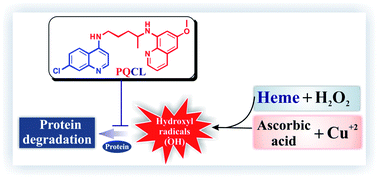Synthesis and biological evaluation of primaquine–chloroquine twin drug: a novel heme-interacting molecule prevents free heme and hydroxyl radical-mediated protein degradation†
Abstract
Accumulations of oxidized and degraded

* Corresponding authors
a
Department of Infectious Diseases and Immunology, CSIR-Indian Institute of Chemical Biology, 4 Raja S. C. Mullick Road, Jadavpur, Kolkata 700032, West Bengal, India
E-mail:
ubandyo_1964@yahoo.com
Fax: +91-33-24730284
Tel: +91-33-24733491
b
Department of Chemistry, University of Calcutta, 92, A. P. C. Road, Kolkata-700 009, West Bengal, India
E-mail:
adhikarisusanta@yahoo.com
Fax: +91-33-23519755
Tel: +91-33-23509937
Accumulations of oxidized and degraded

 Please wait while we load your content...
Something went wrong. Try again?
Please wait while we load your content...
Something went wrong. Try again?
C. Pal, S. Sarkar, S. Mazumder, S. Adhikari and U. Bandyopadhyay, Med. Chem. Commun., 2013, 4, 731 DOI: 10.1039/C3MD00019B
To request permission to reproduce material from this article, please go to the Copyright Clearance Center request page.
If you are an author contributing to an RSC publication, you do not need to request permission provided correct acknowledgement is given.
If you are the author of this article, you do not need to request permission to reproduce figures and diagrams provided correct acknowledgement is given. If you want to reproduce the whole article in a third-party publication (excluding your thesis/dissertation for which permission is not required) please go to the Copyright Clearance Center request page.
Read more about how to correctly acknowledge RSC content.
 Fetching data from CrossRef.
Fetching data from CrossRef.
This may take some time to load.
Loading related content
